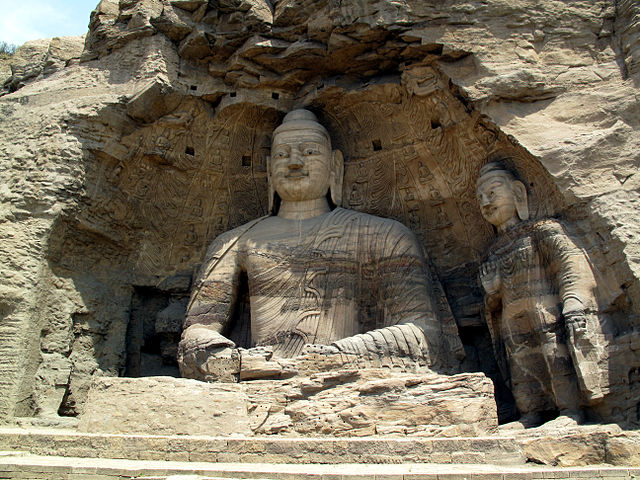
Cave 20
Northern Wei, Period I, 460-465
Yungang Grottoes, Datong

|
Cave 20Northern Wei, Period I, 460-465
|
The 14m-tall seated Buddha of Cave 20 is an icon of Chinese art, comparable to the colossal exposed Buddhas of Dunhuang and Longmen. It was originally flanked by a pair of smaller standing buddhas, of which only the eastern figure now remains. Square holes in the back wall once socketed the beams of a wooden protective facade, now long-gone. The lower parts of the figures have spalled away, a fate shared by many sculptures at Yungang; its soft sandstone rock was ideal for fine carving, evident in the detailing of the Buddha's robe and mandorla, but susceptible to destructive alternations of temperature, wind, and weather. Their faces, although partially restored, have retained the non-Chinese physiognomy that was inherited from their predecessors at Dunhuang; likewise the drapery of their robes is Central Asian, rather than Chinese.
Caves 16-20 are the earliest at Yungang. Their iconography is uncertain, not least because the overall scheme of the caves may have altered in mid-course, between the original three caves (18-20) and two slightly later additions (16-17). These caves are often called the "Tanyao Five," after the powerful Monk Tanyao, who oversaw their construction in his capacity as imperially-appointed supervisor of all Buddhist clergy. Significantly, Tanyao hailed from the Gansu terminus of the Silk Road, and was consequently well-positioned to import the religious architecture of Dunhuang to this new work of the Northern Wei. Various scholars have identified the Tanyao Five buddhas with Northern Wei emperors (compare Empress Wu's Fengxian Si at Longmen), Dhyani Buddhas, and even the Buddha Field of Vairocana (per John Huntington). Contemporary observers would likely have accepted all of these associations, in spite of their theoretical contradictions (see: additive cultures).
The seated Buddha of Cave 20 is either Amitabha (based on his hands-together meditation posture) or Shakyamuni (based on the idea that this cave represents the Three Buddhas of the Past, Present, and Future).

|

|

|